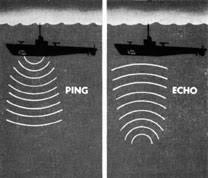In a multiplayer gaming world, there are a lot of things that go into the player having a good gaming experience – particularly if that good experience is dependent upon you winning.
‘Twitchy’ online multiplayer games like FPS (first-person shooters), racing and some MMORPG-type games, particularly depend on the player reacting to the feedback from the game in a timely and effective way. And that chain of feedback and reaction has many links, one of them being you, the player – and one of them being your ‘ping’.
There’s also things like mouse/keyboard input lag, CPU lag, GPU rendering time and monitor refresh rate – we’ll touch on those in a bit.
So What Is a ‘Ping’?

If you’ve ever seen any of those old, World War II submarine movies, you’ll recall a lot of suspenseful scenes where the crew huddle in the darkness listening to a ‘ping’ sound getting faster and faster. That’s a sonar ping – a pulse of sound that goes through the water and bounces back to the emitter, to basically determine how far away something is.
To get technical:
An IP address is your unique internet address.
Information goes from one place on the internet to another in little packets, one after another.
In terms of the internets, a ping refers to latency – how long it takes for a data packet to go from your computer or gaming console to another IP address somewhere else on the internet. Got it?
There are two types of data packets; TCP/IP (Transmission Control Protocol/Internet Protocol) and UDP (User Datagram Protocol).
TCP/IP is slower, as there’s a lot of back-and-forth to make sure the data is where it should be and that all of the data gets through. If a data packet is corrupted, it’ll be asked for again.
UDP is faster; it only checks to make sure that the data isn’t corrupted – if it is bad data, the receiving computer will just ignore it. Games that need to send a lot of data to keep your game updated use UDP.
Which brings us to ..
Packet Loss
Packet loss is something you’ve probably experienced; the game freezes and then suddenly everything is somewhere else.
This happens when the UDP data packets aren’t getting through to you in good shape, so your console/computer is rejecting them.
Why Is My Ping So Bad/Good?
So: your ping is the time it takes a message from your machine to reach the game server (or from the game server to your machine).
A game server is basically the judge of what all the connected players are doing. It knows where everything is and what everything is trying to do, and must decide who did what first – for example, two players firing a stream of bullets at each other.
As far as the server is concerned, the response time that matters is when your response is received by the game client (on your computer or console) and finally transmitted to the server. If you and your opponent both fire at the same, real-world time, but their message gets to the server 20 milliseconds before yours, bing bing! The win goes to your opponent.
(Of course, it’s not always that simple – many systems allow for a certain amount of latency, but hey, another time..)
The server also keeps your game client (the game program on your console or computer) up-to-date with necessary info about what’s going on around them in the virtual world; loot lying around, other players driving past, spells being cast on them, windows being broken. Your game is rendered locally for you to see, and generally shows you moving through this world quickly.
Your game also receives a lot more data about the world than you see – the server hands off the work of calculating that stuff to the game client. The simplest, hardest-to-beat game hacks are the ones that plug in to this information and present it to your sad, pathetic cheater-types, either on a separate program or as an on-screen overlay. Sad, sad people.
The Journey of the Data
The data you send to the server can go on quite an elaborate journey, depending on how far away the server is. If you’re running a server on your own machine, this will be on the order of 1ms. If you’re playing from Brazil and the server is in Iceland, that message takes quite a few jumps. Broadly speaking, here are the steps in the journey:
Start: Your PC / Console
> To Your Router / Modem
> To Your Local Internet Exchange / Node
> To Your ISP
> To .. Internets (this is where stuff can get complicated)
> To Internets > To Other Internets > (Add as needed)
> To Game Server Host / ISP / Data Centre
> To Network Switch
> To Game Server
Reverse the above for the journey from the server to you.
Improving Your Ping
There’s stuff you can do and stuff out of your control.
Your Local Network
Try to plug directly into your router with an Ethernet cable. If you’re paying on WiFi and other people are using that channel heavily, your data is going to have to compete and queue, which will slow things down and possibly cause packet loss.
Your Internet Connection
A complete, gigabit fibre connection is optimal here, but we can’t all have that (yet). When choosing a plan, remember that upload speed is a big factor here. Many people will ‘tether’ their phones – either by USB or by making their phone a wireless ‘hotspot’ – but be warned that some phone companies ‘de-prioritize’ gaming data.
Other Lag Factors
Finally, don’t forget that the complete performance picture is one where you are given the data as quickly as possible and that returns your response the fastest – that is, you see it on the screen as it happens and your controller / keyboard / mouse input is acted upon the fastest.
Essentially, this means getting the meanest, most expensive rig you can – but there are a bunch of cheaper ways to improve things somewhat.
- Use a wired mouse rather than a cheap wireless mouse. Cheaper wireless mouses use older, slower technology to communicate with the PC (some modern, more expensive wireless mouses have pretty good response times, though)
- CPU intensive games need a better CPU (all the better to work out where everything is)
- GPU (graphics card). The more frames per second you see, the more data you have. But remember, a better GPU is only as good as the monitor that it outputs to – if you’re using a 60hz monitor, your graphics card only needs to render at 60 frames per second.
How We Measure Game Server Pings
The eagle-eyed may have spotted that you can’t ping a UDP connection – it only goes one way. So how does gameserverping.com DO it?
Well, it’s a bit of a hack, but it pretty much works.
We get your web browser to send little requests to a web address on a machine adjacent to the game server (or at least, in the same data center). This is about 10% slower than a TCP/IP ping, so allow for that and .. PING!
Thanks for reading. Check out your game pings now at gameserverping.com!
